Investigating the Morphometry and Hydrometeorological Variability of a Fragile Tropical Karstic Lake of the Yucatán Peninsula: Bacalar Lagoon
Abstract
1. Introduction
2. Materials and Methods
2.1. Study Area
2.2. Bathymetry/Field Data Collection and Data Processing
2.3. Morphometric Parameters
2.4. Hydrometeorological Data and ENSO
2.5. In Situ Water Temperature, Water Level Records, and Derived Water Storage Anomaly
2.6. Transparency from Secchi, Aerial Photographs, and Sentinel-2 L1C True Color Images
3. Results
3.1. Bathymetry and Morphometric Description
3.2. Hydrometeorological Variability and Its Effects on Water Temperature and Water Level
3.3. Effect of Tropical Storm Cristobal on Transparency and Color
4. Discussion
4.1. The BL Basin as a Whole
4.2. Natural Disturbances
4.3. Interconnectedness with the Yucatan Aquifer System
4.4. Human-Driven Alterations
5. Conclusions
Author Contributions
Funding
Data Availability Statement
Acknowledgments
Conflicts of Interest
References
- Goldscheider, N.; Chen, Z.; Auler, A.S.; Bakalowicz, M.; Broda, S.; Drew, D.; Hartmann, J.; Jiang, G.; Moosdorf, N.; Stevanovic, Z.; et al. Global Distribution of Carbonate Rocks and Karst Water Resources. Hydrogeol. J. 2020, 28, 1661–1677. [Google Scholar] [CrossRef]
- Perry, E.; Velazquez-Oliman, G.; Marin, L. The Hydrogeochemistry of the Karst Aquifer System of the Northern Yucatan Peninsula, Mexico. Int. Geol. Rev. 2002, 44, 191–221. [Google Scholar] [CrossRef]
- Alcocer, J.; Bernal-Brooks, F.W. Limnology in Mexico. Hydrobiologia 2010, 644, 1–54. [Google Scholar] [CrossRef]
- Lewis, W.M. Tropical Lakes: How Latitude Makes a Difference. In Perspectives in Tropical Limnology; Schiemer, F., Boland, K.T., Eds.; SPB Academic Publishing: Amsterdam, the Netherlands, 1996; pp. 43–64. [Google Scholar]
- Xing, Z.; Fong, D.A.; Yat-Man Lo, E.; Monismith, S.G. Thermal Structure and Variability of a Shallow Tropical Reservoir. Limnol. Oceanogr. 2014, 59, 115–128. [Google Scholar] [CrossRef]
- Boon, P. The Conservation of Fresh Waters: Temperate Experience in a Tropical Context. Trop. Limnol. 1995, 1, 149–159. [Google Scholar]
- Lewis Jr, W.M. Basis for the Protection and Management of Tropical Lakes. Lakes Reserv. Res. Manag. 2000, 5, 35–48. [Google Scholar] [CrossRef]
- Carrillo, L.; Palacios-Hernández, E.; Ramírez, A.M.; Morales-Vela, B. Características Hidrometeorológicas y Batimétricas. In El Sistema Ecológico de la Bahía de Chetumal/Corozal: Costa Occidental del Mar Caribe; El Colegio de la Frontera Sur: Chetumal, Quintana Roo, Mexico, 2009; pp. 12–20. ISBN 978-607-7637-13-4. [Google Scholar]
- Gischler, E.; Gibson, M.A.; Oschmann, W.; Hudson, J.H. Giant Holocene Freshwater Microbialites, Laguna Bacalar, Quintana Roo, Mexico. Sedimentology 2008, 55, 1293–1309. [Google Scholar] [CrossRef]
- Pérez, L.; Bugja, R.; Lorenschat, J.; Brenner, M.; Curtis, J.; Hoelzmann, P.; Islebe, G.; Scharf, B.; Schwalb, A. Aquatic Ecosystems of the Yucatán Peninsula (Mexico), Belize, and Guatemala. Hydrobiologia 2011, 661, 407–433. [Google Scholar] [CrossRef]
- Gischler, E.; Golubic, S.; Gibson, M.A.; Oschmann, W.; Hudson, J.H. Microbial Mats and Microbialites in the Freshwater Laguna Bacalar, Yucatan Peninsula, Mexico. In Advances in Stromatolite Geobiology; Lecture Notes in Earth Sciences; Springer-Verlag: Berlin/Heidelberg, Germany, 2011; pp. 187–205. [Google Scholar]
- Siqueiros-Beltrones, D.A.; Argumedo-Hernández, U.; Hernández-Almeida, O.U. Diagnosis Prospectiva Sobre La Diversidad de Diatomeas Epilíticas En La Laguna Bacalar, Quintana Roo, México. Rev. Mex. Biodivers. 2013, 84, 865–875. [Google Scholar] [CrossRef]
- Johnson, D.; Beddows, P.; Flynn, T.; Osburn, M. Microbial Diversity and Biomarker Analysis of Modern Freshwater Microbialites from Laguna Bacalar, Mexico. Geobiology 2018, 16, 319–337. [Google Scholar] [CrossRef]
- Yanez-Montalvo, A.; Gómez-Acata, S.; Águila, B.; Hernández-Arana, H.; Falcón, L.I. The Microbiome of Modern Microbialites in Bacalar Lagoon, Mexico. PLoS ONE 2020, 15, e0230071. [Google Scholar] [CrossRef] [PubMed]
- Marelli, D.C.; Berrend, R.E. New Species Record for Mytilopsis-Sallei (Recluz) in Central-America (Mollusca Pelecypoda). Veliger 1978, 21, 144. [Google Scholar]
- Elías-Gutiérrez, M.; Valdez-Moreno, M.; Topan, J.; Young, M.R.; Cohuo-Colli, J.A. Improved Protocols to Accelerate the Assembly of DNA Barcode Reference Libraries for Freshwater Zooplankton. Ecol. Evol. 2018, 8, 3002–3018. [Google Scholar] [CrossRef] [PubMed]
- Montes-Ortiz, L.; Elías-Gutiérrez, M. Water Mite Diversity (Acariformes: Prostigmata: Parasitengonina: Hydrachnidiae) from Karst Ecosystems in Southern of Mexico: A Barcoding Approach. Diversity 2020, 12, 329. [Google Scholar] [CrossRef]
- Vinogradova, E.M. Six New Species of Polypedilum Kieffer, 1912, from the Yucatán Peninsula (Insecta, Diptera, Chironomidae). Spixiana 2008, 31, 277–288. [Google Scholar]
- López-Castilla, H.; Cetzal-Ix, W.; Casanova-Lugo, F.; Ramírez-Barajas, P.; Lara-Pérez, L.; Basu, S.; Enríquez-Nolasco, J. Birdlife, a Tourist Attraction for the Southern Portion of Bacalar Lagoon, Quintana Roo, Mexico. Braz. J. Biol. 2023, 83, e275598. [Google Scholar] [CrossRef] [PubMed]
- Valdez-Moreno, M.; Ivanova, N.V.; Elías-Gutiérrez, M.; Pedersen, S.L.; Bessonov, K.; Hebert, P.D.N. Using eDNA to Biomonitor the Fish Community in a Tropical Oligotrophic Lake. PLoS ONE 2019, 14, e0215505. [Google Scholar] [CrossRef] [PubMed]
- Lerman, A.; Imboden, D.M.; Gat, J.R. Physics and Chemistry of Lakes; Springer: Berlin/Heidelberg, Germany, 1995; ISBN 978-3-642-85134-6. [Google Scholar]
- Wetzel, R.G. Limnology: Lake and River Ecosystems; Gulf Professional Publishing: Houston, TX, USA, 2001. [Google Scholar]
- Håkanson, L. The Importance of Lake Morphometry for the Structure and Function of Lakes. Int. Rev. Hydrobiol. J. Cover. Asp. Limnol. Mar. Biol. 2005, 90, 433–461. [Google Scholar] [CrossRef]
- CONAGUA. Presenta El Servicio Meteorológico Nacional Balance de Las Tormentas Tropicales Amanda y Cristobal; Comunicado de Prensa No. 444-20; CONAGUA: Ciudad de Mexico, Mexico, 2020.
- CONAGUA. Reseña de La Tormenta Tropical Cristóbal Del Océano Atlántico; CONAGUA: Ciudad de Mexico, Mexico, 2020.
- Keeley, A. How a Mexican Lagoon Lost Its Colors. New Yorker, 12 July 2021. [Google Scholar]
- Bauer-Gottwein, P.; Gondwe, B.R.N.; Charvet, G.; Marín, L.E.; Rebolledo-Vieyra, M.; Merediz-Alonso, G. Review: The Yucatán Peninsula Karst Aquifer, Mexico. Hydrogeol. J. 2011, 19, 507–524. [Google Scholar] [CrossRef]
- Burkart, B. Northern Central America. In Caribbean Geology: Introduction; Donovan, S.K., Jackson, T.A., Eds.; The University of the West Indies Publisher’s Assocaition (UWIPA): Kingston, Jamaica, 1994; pp. 265–284. [Google Scholar]
- Isphording, W.C. The Physical Geology of Yucatan. Gulf Coast Assoc. Geol. Soc. 1975, 25, 231–262. [Google Scholar]
- Miller, T.E. Geologic and Hydrologic Controls on Karst and Cave Development in Belize. J. Cave Karst Stud. 1996, 58, 100–120. [Google Scholar]
- Matzuk, R.M. Water Chemistry and Lake Dynamics of Laguna Bacalar, Quintana Roo, Mexico. Ph.D. Thesis, The University of Wisconsin-Milwaukee, Milwaukee, WI, USA, 2020. [Google Scholar]
- Perry, E.; Velazquez-Oliman, G.; Socki, R.A. Hydrogeology of the Yucatán Peninsula. In The Lowland Maya Area: Three Millennia at the Human-Wildland Interface; Gómez-Pompa, A., Allen, M., Fedick, S.L., Jiménez-Osorio, J.J., Eds.; Food Products Press: New York, NY, USA, 2003; pp. 115–138. [Google Scholar]
- Sánchez-Sánchez, J.A.; Álvarez-Legorreta, T.; Pacheco-Ávila, J.G.; González-Herrera, R.A.; Carrillo-Bribiezca, L. Caracterización Hidrogeoquímica de Las Aguas Subterráneas Del Sur Del Estado de Quintana Roo, México. Rev. Mex. Cienc. Geológicas 2015, 32, 62–76. [Google Scholar]
- Tobón Velázquez, N.; Rebolledo Vieyra, M.; Paytan, A.; Broach, K.H.; Hernández Terrones, L.M. Hydrochemistry and Carbonate Sediment Characterisation of Bacalar Lagoon, Mexican Caribbean. Mar. Freshw. Res. 2019, 70, 382. [Google Scholar] [CrossRef]
- Gondwe, B.R.N.; Lerer, S.; Stisen, S.; Marín, L.; Rebolledo-Vieyra, M.; Merediz-Alonso, G.; Bauer-Gottwein, P. Hydrogeology of the South-Eastern Yucatan Peninsula: New Insights from Water Level Measurements, Geochemistry, Geophysics and Remote Sensing. J. Hydrol. 2010, 389, 1–17. [Google Scholar] [CrossRef]
- Cervantes-Martínez, A.; Mezeta-Barrera, M.; Gutiérrez-Aguirre, M. Basic Limnology of the Karstic Tourist Lake Cenote Azul in Quintana Roo, Mexico. Hidrobiológica 2009, 19, 177–180. [Google Scholar]
- Montes-Ortiz, L.; Elias-Gutierrez, M. Faunistic Survey of the Zooplankton Community in an Oligotrophic Sinkhole, Cenote Azul (Quintana Roo, Mexico), Using Different Sampling Methods, and Documented with DNA Barcodes. J. Limnol. 2018, 77, 428–440. [Google Scholar] [CrossRef]
- de Jesús-Navarrete, A.; Legorreta, T.Á. Biological Traits Analysis of Free-Living Nematodes as Indicators of Environmental Quality at Lake Bacalar, Mexico. Limnology 2022, 23, 355–364. [Google Scholar] [CrossRef]
- Castro-Contreras, S.I.; Gingras, M.K.; Pecoits, E.; Aubet, N.R.; Petrash, D.; Castro-Contreras, S.M.; Dick, G.; Planavsky, N.; Konhauser, K.O. Textural and Geochemical Features of Freshwater Microbialites from Laguna Bacalar, Quintana Roo, Mexico. PALAIOS 2014, 29, 192–209. [Google Scholar] [CrossRef]
- Beltrán Díaz, Y. Estimación de Los Patrones de Fijación de Nitrógeno y Diversidad Asociada (nifH) En Tapices Microbianos y Estromatolitos. Master’s Thesis, Universidad Nacional Autónoma de México. Instituto de Ecología, Mexico City, Mexico, 2010. [Google Scholar]
- Hernández-Martínez, J.L.; Perera-Burgos, J.A.; Acosta-González, G.; Alvarado-Flores, J.; Li, Y.; Leal-Bautista, R.M. Assessment of Physicochemical Parameters by Remote Sensing of Bacalar Lagoon, Yucatán Peninsula, Mexico. Water 2023, 16, 159. [Google Scholar] [CrossRef]
- Oliva-Rivera, J.J.; Ocaña, F.A.; De Jesús-Navarrete, A.; De Jesús-Carrillo, R.M.; Vargas-Espósitos, A.A. Reproducción de Pomacea Flagellata (Mollusca: Ampullariidae) En La Laguna de Bacalar, Quintana Roo, México. Rev. Biol. Trop. 2016, 64, 1643–1650. [Google Scholar] [CrossRef] [PubMed]
- Mooers, C.N.K.; Maul, G.A. Intra-Americas Sea Circulation. In Global Coastal Ocean; Robinson, R., Brink, K.H., Eds.; The Sea; John Wiley & Sons: Hoboken, NJ, USA, 1998; Volume 11, pp. 183–208. [Google Scholar]
- Wang, C. Variability of the Caribbean Low-Level Jet and Its Relations to Climate. Clim. Dyn. 2007, 29, 411–422. [Google Scholar] [CrossRef]
- Rivera-Monroy, V.H.; Farfán, L.M.; Brito-Castillo, L.; Cortés-Ramos, J.; González-Rodríguez, E.; D’Sa, E.J.; Euan-Avila, J.I. Tropical Cyclone Landfall Frequency and Large-Scale Environmental Impacts along Karstic Coastal Regions (Yucatan Peninsula, Mexico). Appl. Sci. 2020, 10, 5815. [Google Scholar] [CrossRef]
- Mosiño, P.; García, E. The Climate of Mexico. Climates of North America. World Surv. Climatol. 1974, 11, 345–404. [Google Scholar]
- CONAGUA. Actualización de La Disponibilidad Media Anual de Agua En El Acuífero Península de Yucatán (3105), Estado de Yucatán; CONAGUA: Ciudad de Mexico, Mexico, 2020.
- Magaña, V.; Amador, J.A.; Medina, S. The Midsummer Drought over Mexico and Central America. J. Clim. 1999, 12, 1577–1588. [Google Scholar] [CrossRef]
- Márdero, S.; Nickl, E.; Schmook, B.; Schneider, L.; Rogan, J.; Christman, Z.; Lawrence, D. Sequías En El Sur de La Península de Yucatán: Análisis de La Variabilidad Anual y Estacional de La Precipitación. Investig. Geográficas 2012, 78, 19–33. [Google Scholar] [CrossRef]
- Kurczyn, J.A.; Appendini, C.M.; Beier, E.; Sosa-López, A.; López-González, J.; Posada-Vanegas, G. Oceanic and Atmospheric Impact of Central American Cold Surges (Nortes) in the Gulf of Mexico. Int. J. Climatol. 2021, 41, E1450–E1468. [Google Scholar] [CrossRef]
- Burrough, P.A. Principles of Geographical Information Systems for Land Resources Assessment. Monographs on Soil and Resources Survey; Oxford University Press: Oxford, UK, 1986; Volume 12. [Google Scholar]
- Wetzel, R.G.; Likens, G.E. Limnological Analyses; Springer: New York, NY, USA, 2000; ISBN 978-1-4757-4100-1. [Google Scholar]
- Rooy, M. A Rainfall Anomally Index Independent of Time and Space. Notos 1965, 14, 43. [Google Scholar]
- Wolter, K.; Timlin, M.S. Measuring the Strength of ENSO Events: How Does 1997/98 Rank? Weather 1998, 53, 315–324. [Google Scholar] [CrossRef]
- Wolter, K.; Timlin, M.S. Monitoring ENSO in COADS with a Seasonally Adjusted Principal Component Index. In Proceedings of the 17th Climate Diagnostics Workshop, Norman, OK, USA, 18–23 October 1993; Volume 52. [Google Scholar]
- Thomson, R.E.; Emery, W.J. Data Analysis Methods in Physical Oceanography; Newnes: Oxford, UK, 2014. [Google Scholar]
- Tourian, M.J.; Elmi, O.; Shafaghi, Y.; Behnia, S.; Saemian, P.; Schlesinger, R.; Sneeuw, N. HydroSat: Geometric Quantities of the Global Water Cycle from Geodetic Satellites. Earth Syst. Sci. Data 2022, 14, 2463–2486. [Google Scholar] [CrossRef]
- Mayer-Gürr, T.; Behzadpur, S.; Ellmer, M.; Kvas, A.; Klinger, B.; Strasser, S.; Zehentner, N. ITSG-Grace2018-Monthly, Daily and Static Gravity Field Solutions from GRACE. Data set/Database. 2018. [Google Scholar] [CrossRef]
- Kvas, A.; Behzadpour, S.; Ellmer, M.; Klinger, B.; Strasser, S.; Zehentner, N.; Mayer-Gürr, T. ITSG-Grace2018: Overview and Evaluation of a New GRACE-Only Gravity Field Time Series. J. Geophys. Res. Solid Earth 2019, 124, 9332–9344. [Google Scholar] [CrossRef]
- Klees, R.; Zapreeva, E.; Winsemius, H.; Savenije, H. The Bias in GRACE Estimates of Continental Water Storage Variations. Hydrol. Earth Syst. Sci. 2007, 11, 1227–1241. [Google Scholar] [CrossRef]
- Seekell, D.A.; Byström, P.; Karlsson, J. Lake Morphometry Moderates the Relationship between Water Color and Fish Biomass in Small Boreal Lakes. Limnol. Oceanogr. 2018, 63, 2171–2178. [Google Scholar] [CrossRef]
- Kebedew, M.G.; Kibret, A.A.; Tilahun, S.A.; Belete, M.A.; Zimale, F.A.; Steenhuis, T.S. The Relationship of Lake Morphometry and Phosphorus Dynamics of a Tropical Highland Lake: Lake Tana, Ethiopia. Water 2020, 12, 2243. [Google Scholar] [CrossRef]
- Carrillo, L.; Palacios-Hernández, E.; Yescas, M.; Ramírez-Manguilar, A.M. Spatial and Seasonal Patterns of Salinity in a Large and Shallow Tropical Estuary of the Western Caribbean. Estuaries Coasts 2009, 32, 906–916. [Google Scholar] [CrossRef]
- Alcérreca-Huerta, J.C.; Álvarez-Legorreta, T.; Carrillo, L.; Flórez-Franco, L.M.; Reyes-Mendoza, O.F.; Sánchez-Sánchez, J.A. First Insights into an Exceptionally Deep Blue Hole in the Western Caribbean: The Taam Ja’Blue Hole. Front. Mar. Sci. 2023, 10, 346. [Google Scholar] [CrossRef]
- Pope, K.O.; Ocampo, A.C.; Fischer, A.G.; Vega, F.J.; Ames, D.E.; King Jr, D.T.; Fouke, B.W.; Wachtman, R.J.; Kletetschka, G. Chicxulub Impact Ejecta Deposits in Southern Quintana Roo, México, and Central Belize. Geol. Soc. Am. Spec. Pap. 2005, 384, 171–190. [Google Scholar]
- Perry, E.C.; Leal-Bautista, R.M.; Velázquez-Olimán, G.; Sánchez-Sánchez, J.A.; Wagner, N. Aspects of the Hydrogeology of Southern Campeche and Quintana Roo, Mexico. Bol. Soc. Geológica Mex. 2021, 73, A011020. [Google Scholar] [CrossRef]
- Zhao, Z.; Han, M.; Yang, K.; Holbrook, N.J. Signatures of Midsummer Droughts over Central America and Mexico. Clim. Dyn. 2022, 60, 3523–3542. [Google Scholar] [CrossRef]
- CONAGUA. Estado Del Clima En México Durante 2020 y Perspectivas Para 2021; CONAGUA: Ciudad de Mexico, Mexico, 2021.
- Talling, J. Environmental Controls on the Functioning of Shallow Tropical Lakes. Hydrobiologia 2001, 458, 1–8. [Google Scholar] [CrossRef]
- Bhateria, R.; Jain, D. Water Quality Assessment of Lake Water: A Review. Sustain. Water Resour. Manag. 2016, 2, 161–173. [Google Scholar] [CrossRef]
- Hernández-Cerda, M.E.; Azpra Romero, E.; Lomas Barrié, C.T. Cristóbal, the Tropical Storm in 2020 That Left Atypical Rainfall in the Yucatan Peninsula. Entorno Geográfico 2021, 125–156. [Google Scholar] [CrossRef]
- Castro-Chan, R.A.; De Jesús Navarrete, A.; Zavala Mendoza, A. Estudio Para Establecer Las Causas de La Mortalidad Masiva Del Caracol de Agua Dulce Chivita Pomacea Flagellata; Consejo Quintanarroense de Ciencia y Tecnología: Chetumal, Mexico, 2021.
- Álvarez-Legorreta, T.; Carrillo-Bibriezca, L.; De Jesús Navarrete, A.; Herrera-Silveira, J.; Gutiérrez, M.; Cervantes, A. Desarrollo de Indicadores de Calidad Del Agua En Lagunas Costeras y Continentales de Quintana Roo Para El Diseño e Implementación de Un Programa de Monitoreo Estatal; FOMIX: Chetumal, Quintana Roo, Mexico, 2011; p. 174. [Google Scholar]
- Álvarez-Legorreta, T. ¿La calidad del agua de Laguna Bacalar ha cambiado? In: Foro 2020 Agua Clara Bacalar. Situación Actual de la Laguna de Bacalar. Agua Clara: Bacalar, Mexico. 2020. Available online: https://www.youtube.com/watch?v=7nqy_lei-xI (accessed on 13 February 2023).
- CONAGUA. Reseña Del Huracán “Dean” Del Océano Atlántico; CONAGUA: Ciudad de Mexico, Mexico, 2007.
- Islebe, G.; Torrescano-Valle, N.; Valdéz-Hernández, M.; Tuz-Novelo, M.; Weissenberger, H. Efectos Del Impacto Del Huracán Dean En La Vegetación Del Sureste de Quintana Roo, México. For. Veracruzana 2009, 11, 1–6. [Google Scholar]
- Ramírez-Barajas, P.J.; Islebe, G.; Torrescano-Valle, N. Post-Hurricane Dean Impact on Habitat and Its Influence on the Relative Abundance of Large Vertebrates in the Selva Maya, Quintana Roo, Mexico. Rev. Mex. Biodivers. 2012, 83, 1194–1207. [Google Scholar]
- CONAGUA. Reseña Del Huracán Karl Del Océano Atlántico; CONAGUA: Ciudad de Mexico, Mexico, 2010.
- Perry, E.; Paytan, A.; Pedersen, B.; Velazquez-Oliman, G. Groundwater Geochemistry of the Yucatan Peninsula, Mexico: Constraints on Stratigraphy and Hydrogeology. J. Hydrol. 2009, 367, 27–40. [Google Scholar] [CrossRef]
- Perry, E.C.; Velazquez-Oliman, G.; Leal-Bautista, R.M.; Dunning, N.P. The Icaiche Formation: Major Contributor to the Stratigraphy, Hydrogeochemistry and Geomorphology of the Northern Yucatán Peninsula, Mexico. Bol. Soc. Geológica Mex. 2019, 71, 741–760. [Google Scholar] [CrossRef]
- CONAGUA. Se Mantiene en Vigilancia el Nivel del Río Champotón en Campeche; CONAGUA: Ciudad de Mexico, Mexico, 2020; p. 1.
- SEDETUR. Indicadores Turísticos. Available online: https://qroo.gob.mx/sedetur/indicadores-turisticos (accessed on 6 January 2022).
- Rojas-Castillo, L.A.; Calderón-Maya, J.R. Etapas Del Proceso de Urbanización En La Ciudad de Bacalar, Quintana Roo (México). Quivera Rev. Estud. Territ. 2022, 25, 5–19. [Google Scholar] [CrossRef]
- Gómez-García, M. Evaluación Del Cambio de Uso de Suelo Ocasionado Por Actividades Antrópicas En El Área Del Programa de Ordenamiento Ecológico Territorial de Bacalar, Quintana Roo. Bachelor’s Thesis, Universidad Nacional Autónoma de México, Mexico City, Mexico, 2018. [Google Scholar]
- INEGI. Censo de población y vivienda 2020. Available online: https://www.inegi.org.mx/programas/ccpv/2020/default.html (accessed on 31 May 2022).
- Huchin-Ochoa, S.A.; Navarro-Martínez, A.; Ellis, E.A.; Hernández Gómez, I.U. Deforestación En El Municipio de Bacalar, Quintana Roo, México Durante El Período 1993–2017. Madera Bosques 2022, 28, e2832396. [Google Scholar] [CrossRef]
- Ellis, E.A.; Navarro Martínez, A.; García Ortega, M.; Hernández Gómez, I.U.; Castillo, D.C. Forest Cover Dynamics in the Selva Maya of Central and Southern Quintana Roo, Mexico: Deforestation or Degradation? J. Land Use Sci. 2020, 15, 25–51. [Google Scholar] [CrossRef]
- Gómez-Pech, E.H.; Barrasa García, S.; García de Fuentes, A. Paisaje Litoral de La Laguna de Bacalar (Quintana Roo, México): Ocupación Del Suelo y Producción Del Imaginario Por El Turismo. Investig. Geográficas 2018. [Google Scholar] [CrossRef]
- Smith, D.N.; Ortega-Camacho, D.; Acosta-González, G.; Leal-Bautista, R.M.; Fox, W.E.; Cejudo, E. A Multi-Approach Assessment of Land Use Effects on Groundwater Quality in a Karstic Aquifer. Heliyon 2020, 6, e03970. [Google Scholar] [CrossRef] [PubMed]
- UNESCO. UN-Water United Nations World Water Development Report 2020: Water and Climate Change; UNESCO: Paris, France, 2020. [Google Scholar]
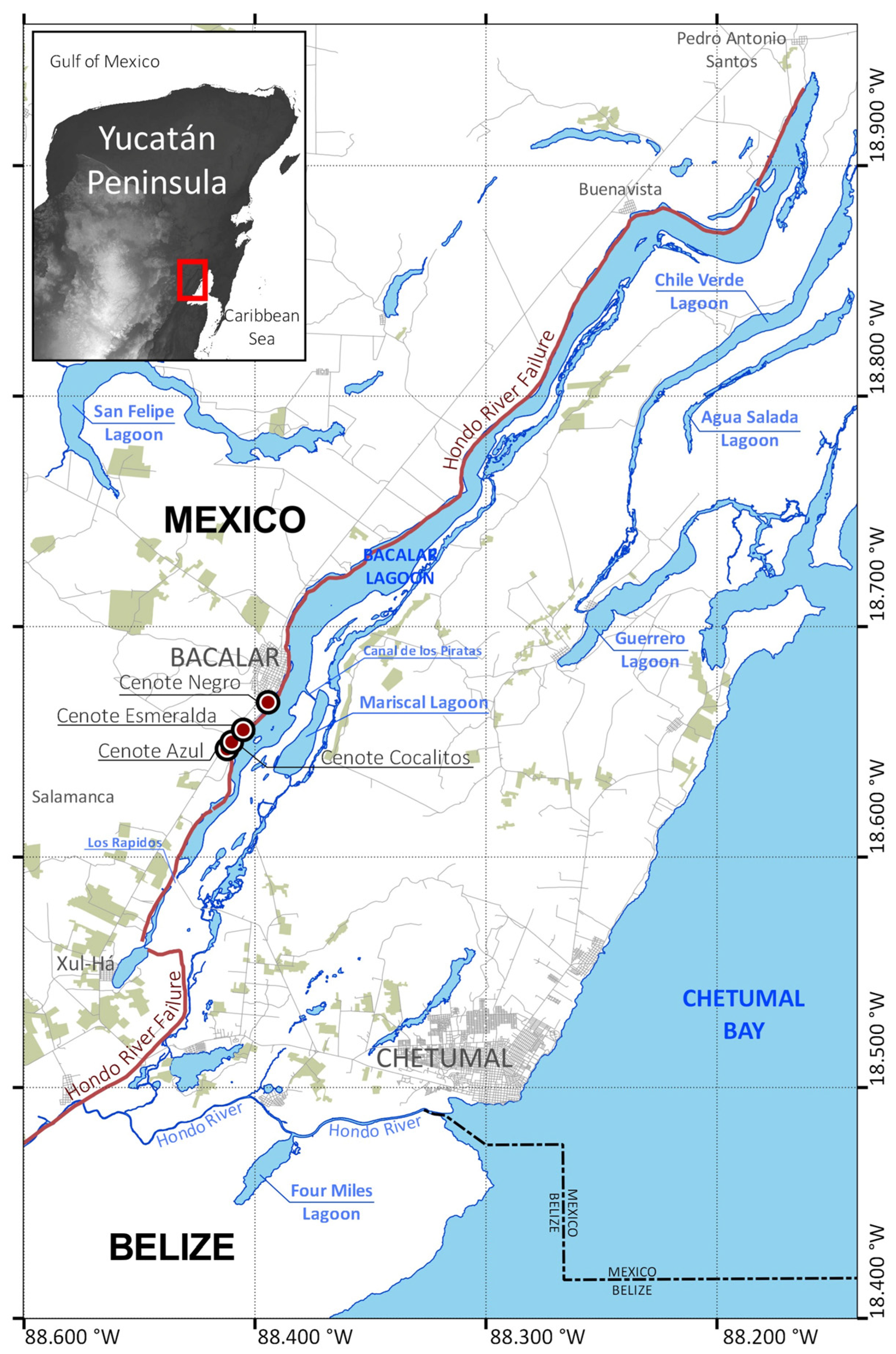
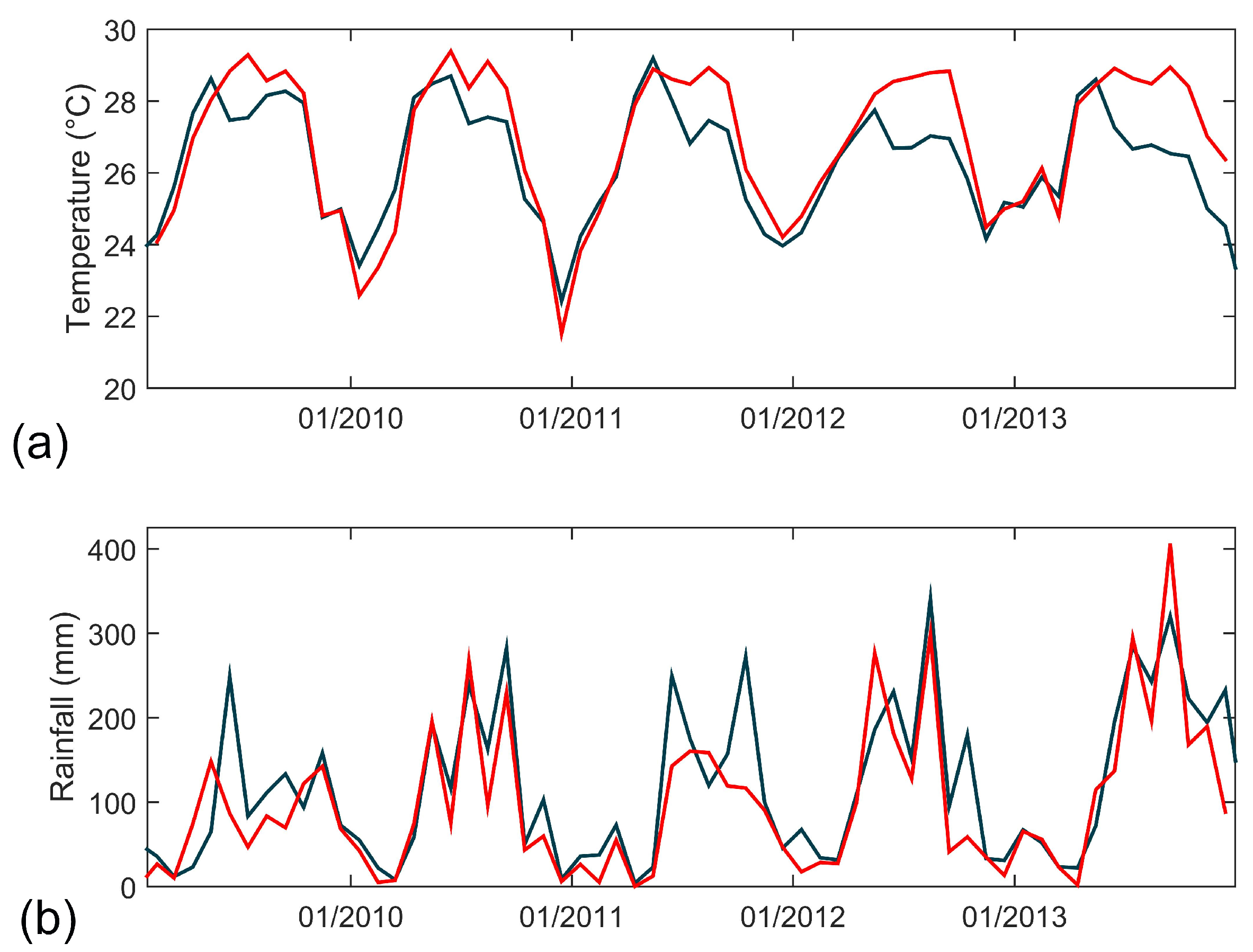
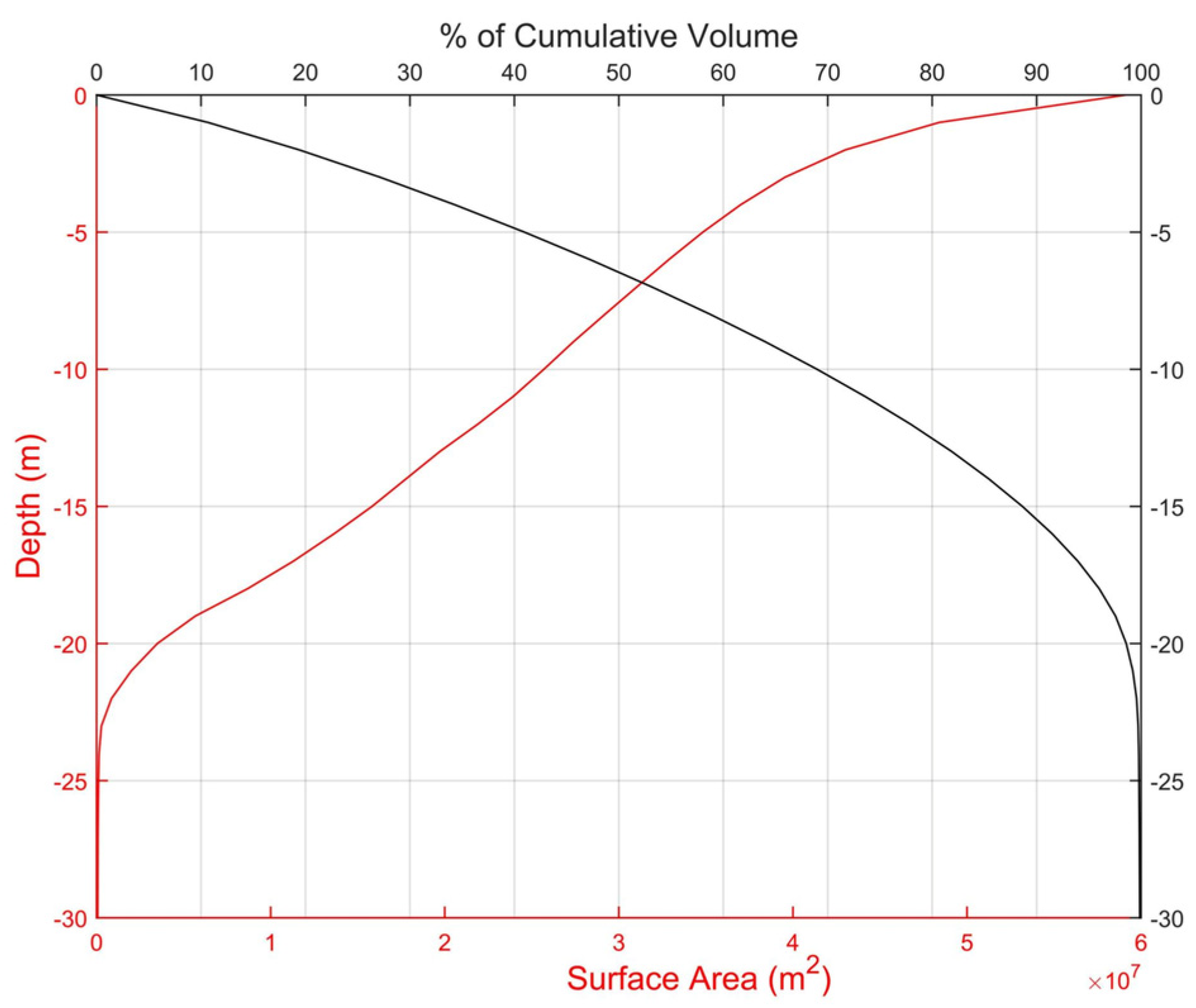

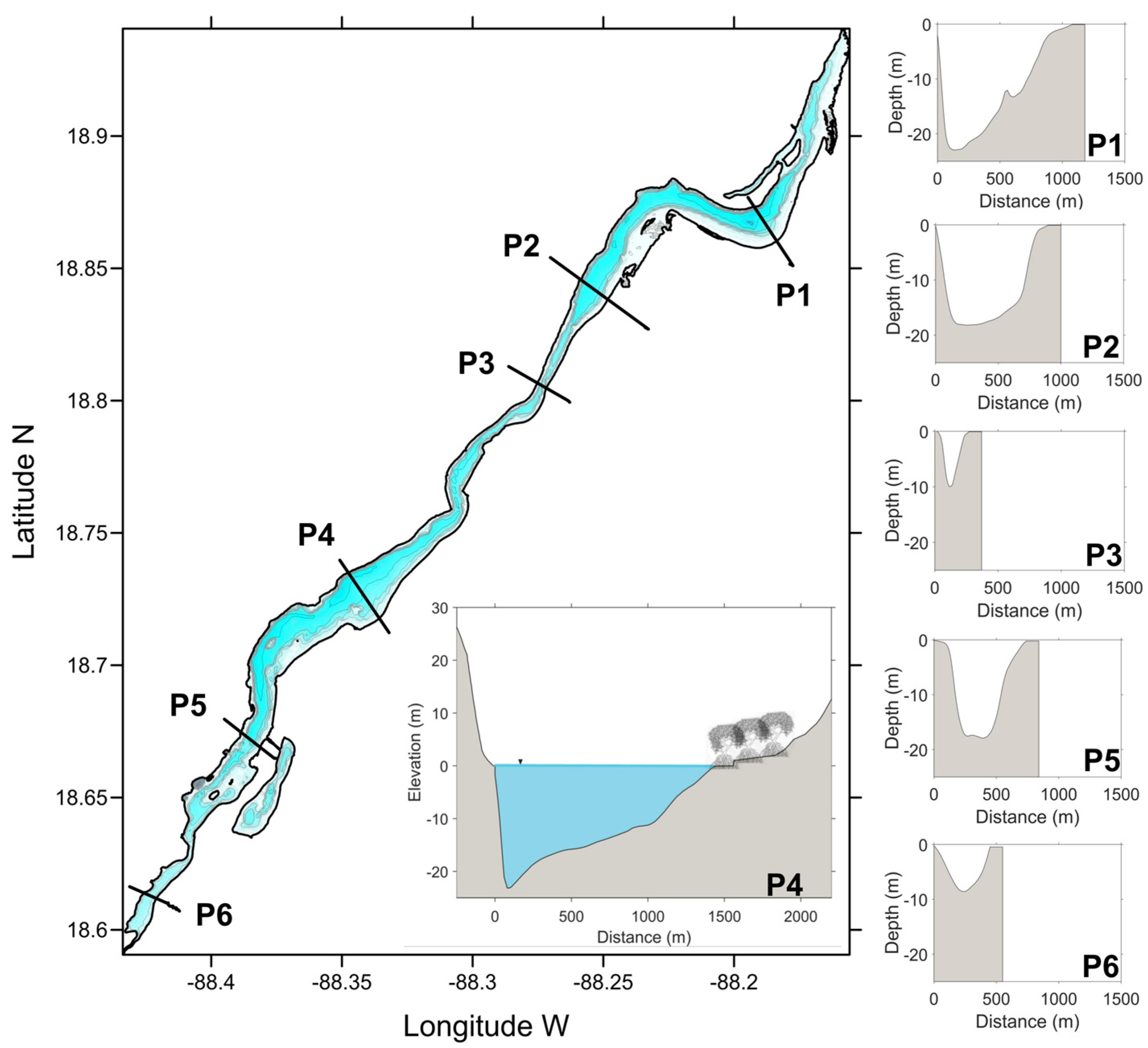


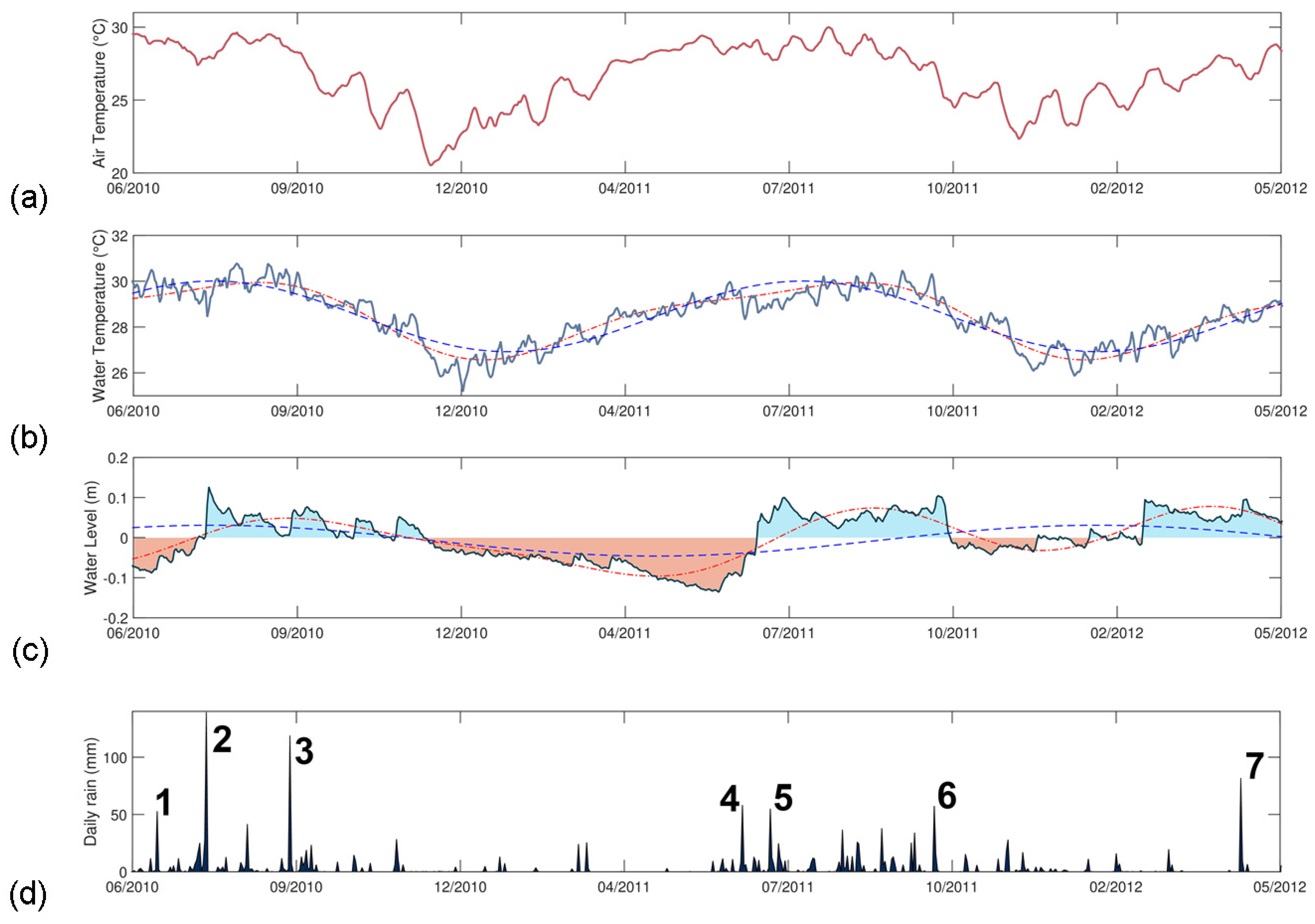

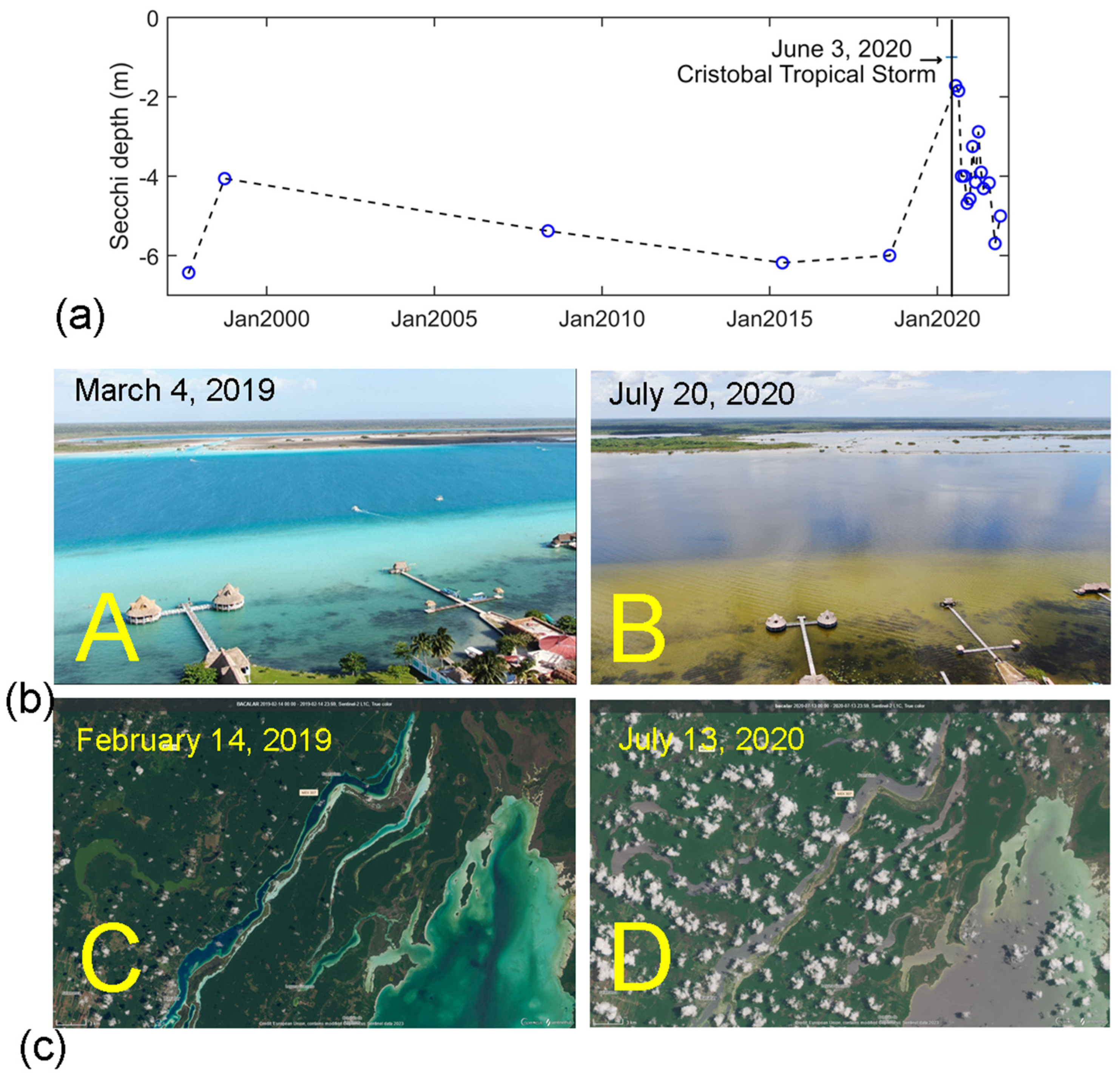
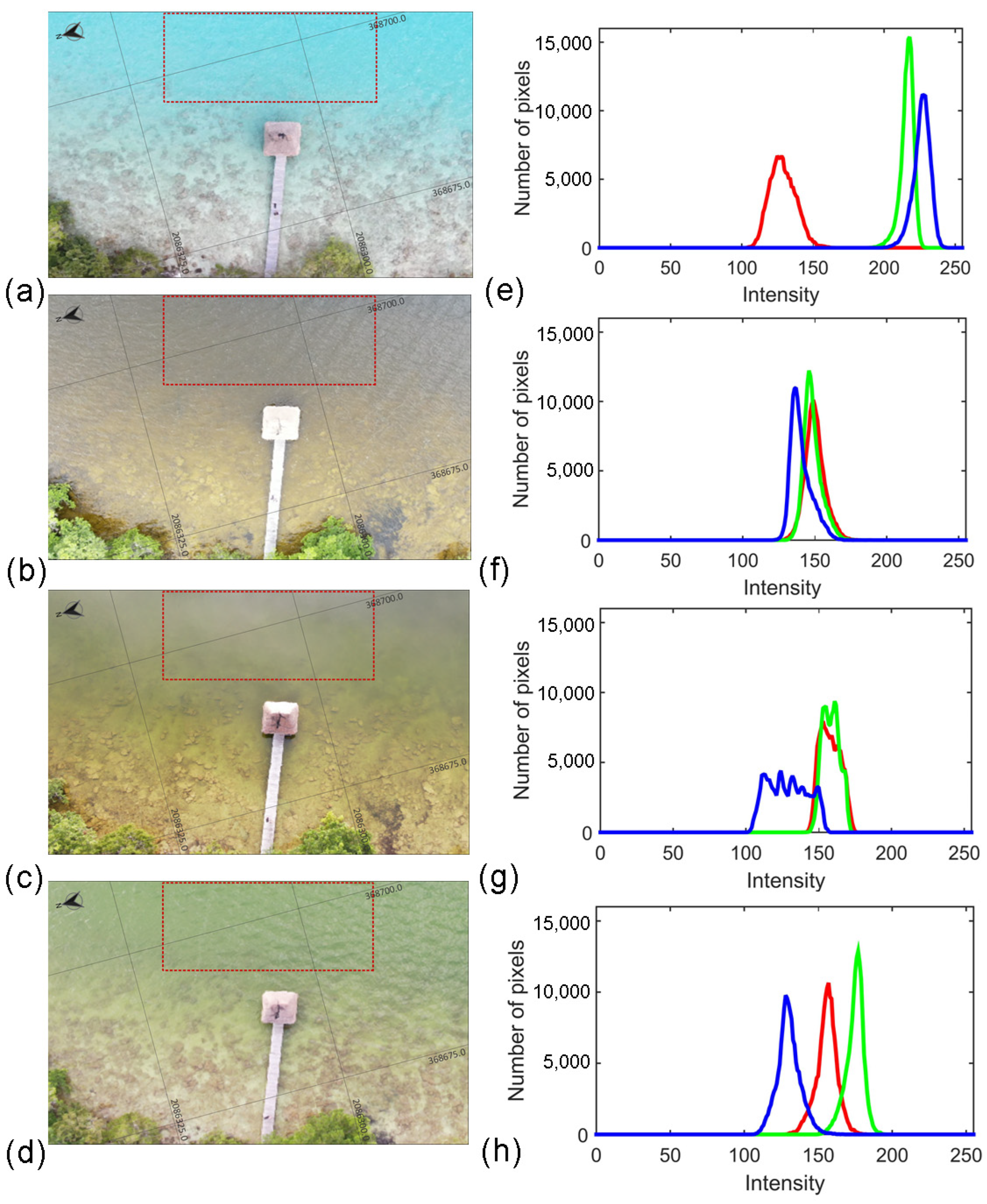
| Main Body | Mariscal Lagoon | |
|---|---|---|
| Maximum length (m) | 52,667 | 4464 |
| Surface Area (Ao) (m2) | 59,127,235 | 3,352,366 |
| Shoreline length L (m) | 168,861 | 10,870 |
| Shoreline development index (DL) | 6.19 | 1.67 |
| Mean depth (m) | 8.85 | 5 |
| Maximum depth (m) * | 26 | 17.7 |
| Lake volume (m3) | 554,398,900 | 16,655,607 |
| Variable | Mean | Standard Dev. | Maximum | Minimum |
|---|---|---|---|---|
| Air temperature (°C) | 26.7 | 1.8 | 31.0 | 16.5 |
| Relative humidity (%) | 77.8 | 7.4 | 95.8 | 42.9 |
| Daily rainfall (mm/day) | 3.7 | 8.3 | 153.7 | 0.0 |
| Monthly rainfall (mm/month) | 109.2 | 57.9 | 187.8 | 34.6 |
Disclaimer/Publisher’s Note: The statements, opinions and data contained in all publications are solely those of the individual author(s) and contributor(s) and not of MDPI and/or the editor(s). MDPI and/or the editor(s) disclaim responsibility for any injury to people or property resulting from any ideas, methods, instructions or products referred to in the content. |
© 2024 by the authors. Licensee MDPI, Basel, Switzerland. This article is an open access article distributed under the terms and conditions of the Creative Commons Attribution (CC BY) license (https://creativecommons.org/licenses/by/4.0/).
Share and Cite
Carrillo, L.; Yescas, M.; Nieto-Oropeza, M.O.; Elías-Gutiérrez, M.; Alcérreca-Huerta, J.C.; Palacios-Hernández, E.; Reyes-Mendoza, O.F. Investigating the Morphometry and Hydrometeorological Variability of a Fragile Tropical Karstic Lake of the Yucatán Peninsula: Bacalar Lagoon. Hydrology 2024, 11, 68. https://doi.org/10.3390/hydrology11050068
Carrillo L, Yescas M, Nieto-Oropeza MO, Elías-Gutiérrez M, Alcérreca-Huerta JC, Palacios-Hernández E, Reyes-Mendoza OF. Investigating the Morphometry and Hydrometeorological Variability of a Fragile Tropical Karstic Lake of the Yucatán Peninsula: Bacalar Lagoon. Hydrology. 2024; 11(5):68. https://doi.org/10.3390/hydrology11050068
Chicago/Turabian StyleCarrillo, Laura, Mario Yescas, Mario Oscar Nieto-Oropeza, Manuel Elías-Gutiérrez, Juan C. Alcérreca-Huerta, Emilio Palacios-Hernández, and Oscar F. Reyes-Mendoza. 2024. "Investigating the Morphometry and Hydrometeorological Variability of a Fragile Tropical Karstic Lake of the Yucatán Peninsula: Bacalar Lagoon" Hydrology 11, no. 5: 68. https://doi.org/10.3390/hydrology11050068
APA StyleCarrillo, L., Yescas, M., Nieto-Oropeza, M. O., Elías-Gutiérrez, M., Alcérreca-Huerta, J. C., Palacios-Hernández, E., & Reyes-Mendoza, O. F. (2024). Investigating the Morphometry and Hydrometeorological Variability of a Fragile Tropical Karstic Lake of the Yucatán Peninsula: Bacalar Lagoon. Hydrology, 11(5), 68. https://doi.org/10.3390/hydrology11050068










